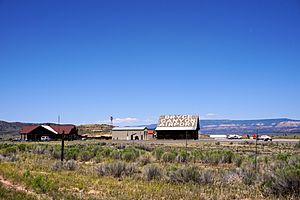Bryce Canyon Airport facts for kids
Quick facts for kids
Bryce Canyon Airport
|
|||||||||||
|---|---|---|---|---|---|---|---|---|---|---|---|
 |
|||||||||||
| Summary | |||||||||||
| Airport type | Public | ||||||||||
| Owner | Garfield County | ||||||||||
| Serves | Bryce Canyon, Utah | ||||||||||
| Elevation AMSL | 7,590 ft / 2,313 m | ||||||||||
| Coordinates | 37°42′23″N 112°08′42″W / 37.70639°N 112.14500°W | ||||||||||
| Runway | |||||||||||
|
|||||||||||
| Statistics (2004) | |||||||||||
|
|||||||||||
|
Source: Federal Aviation Administration
|
|||||||||||
Bryce Canyon Airport is a public airport located about 4 miles (6 km) north of Bryce Canyon National Park in Garfield County, Utah, United States. It is owned by Garfield County. This airport is important because it is very close to famous natural spots like Bryce Canyon National Park and the Grand Staircase–Escalante National Monument.
Contents
What the Airport Has
Bryce Canyon Airport covers an area of about 215 acres (87 hectares). It has one main runway for planes to take off and land. This runway is made of asphalt and is about 7,395 feet (2,254 meters) long and 75 feet (23 meters) wide.
How Busy is the Airport?
In one year (ending December 31, 2004), the airport had 3,132 aircraft operations. An "aircraft operation" means one takeoff or one landing.
- About 57% of these were general aviation flights. These are usually smaller, private planes.
- About 26% were air taxi flights. These are like small charter flights that take people to specific places.
- About 17% were scheduled commercial flights. These are regular flights that follow a set timetable.
Charter Airlines You Might See
Charter airlines offer flights that are not on a regular schedule. You can book them to fly to a specific place at a specific time. Some airlines that have used Bryce Canyon Airport include:
- Air Grand Canyon (flying to Prescott, South Rim Grand Canyon)
- Air Vegas (flying to Las Vegas)
- Talon Air (flying to Las Vegas)
- Grand Canyon Airlines
- King Air (flying to Henderson)
- Westwind (flying to Deer Valley, Page, Phoenix)
A Special Hangar at the Airport
The Garfield County Airport Hangar is a very unique building at Bryce Canyon Airport. It's special because it's built mostly from logs!
How the Hangar Was Built
This hangar was built in 1936 by the Works Progress Administration (WPA). The WPA was a government program during the Great Depression that helped people find jobs by building public projects. The hangar was made using local ponderosa pine trees.
The roof of the hangar is supported by large wooden beams called trusses. These trusses are 83 feet (25 meters) long. You can see these wooden supports on the outside of the building, filled in with rounded log pieces. This gives it a cool, old-fashioned look, almost like a "half-timbered" house.
Why the Hangar is Important
The hangar and the airport were built by Garfield County and the WPA to help bring more visitors to Bryce Canyon National Park. The park had become a national park in 1928, and they wanted to make it easier for tourists to get there.
The wood used for the hangar even shows marks from insects that had been in the trees. These trees were cut down as part of a plan to remove trees that had been damaged by beetles. This hangar is special because it used local building styles and materials to create a modern building for a new type of transportation – airplanes!
Because of its unique design and history, Bryce Canyon Airport was added to the National Register of Historic Places in 1978.

